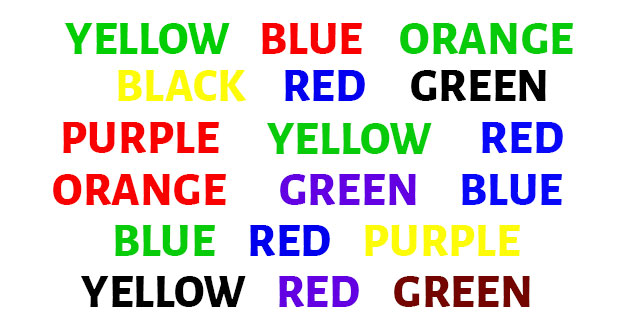DO YOU USE STROOP EFFECT IN YOUR BRAND RESEARCH?
Let’s discuss the Stroop effect.
We’ve all come across this (refer to the image). It’s usually part of an online quiz or a game where some colored words are displayed, and you’re asked to mention the text color.

Not many know the background of this
STROOP EXPERIMENTS – A BRIEF HISTORY
In the 1930s, the American psychologist John Ridley Stroop conducted a series of experiments for his psychological research. Stroop’s experiments involved presenting participants with words printed in black ink, congruent and incongruent colors, and measuring their response times.
- Neutral: ‘Red’ ‘Blue’, etc., printed in black ink
- Nongruent: ‘Red’ printed in red ink; ‘Blue’ printed in blue ink, and so on
- Incongruent: ‘Red’ printed in any other color except red, and so on
The experiments revealed that individuals took a longer response time to identify the color of the text when it conflicted with the word’s meaning.
Used in experimental and clinical psychology, the Stroop effect gives intriguing insights into how our brains process conflicting stimuli.
If you’ve taken a Stroop test, you’d probably understand. Processing the text color and ignoring the word is trickier than processing the word and ignoring the text color.
The reason for this is, processing words is easier for the human brain than processing colors. Reading words is an automated, involuntary process for the brain. This also explains why we have no difficulty in reading misspelt words.
Now let’s talk business.
DOES THE STROOP EFFECT HOLD PRACTICAL IMPLICATIONS TO UNDERSTAND CONSUMER BEHAVIOR ON A DEEPER LEVEL?
Yes. It does.
You need congruency across your marketing mix if you wish to make your brand cut through the static. How about using the Stroop effect in your brand research to check for congruency?
Cognitive dissonance is kind of a big deal when it comes to consumer behavior. You can’t afford to confuse your consumers. You can use the Stroop effect to avoid this.
LET’S DISCUSS SOME CONTEXTS IN WHICH THE STROOP EFFECT COMES IN HANDY.
I. EVALUATING PACKAGING DESIGNS
Imagine you’ve developed some new packaging design options for your brand. You want to conduct packaging research to evaluate the most preferred design.
While conducting research, you can present the participants with the design options and measure the response times taken to evoke desired associations with the brand. This will help you assess the brand fit, purchase intent, and communication effectiveness of your designs.
Conduct a Stroop task by displaying the design to the participants for a few seconds and ask them to recall what they remember from the design. This helps you assess which design elements captured attention effectively.
II. ASSESSING ADVERTISING EFFECTIVENESS
Use the Stroop effect to evaluate the effectiveness of advertisements in influencing brand recognition, message retention, and emotional response.
For instance, the participants may be presented with ad slogans overlaid with conflicting emotional words to validate the congruency between the message and desired emotional response.
III. BRAND PERCEPTION STUDIES
When conducting brand perception studies, use the Stroop effect to assess your brand associations and consumer attitudes.
Make the respondents associate brand stimuli with different attributes and analyze the response times. This might give you insights into subconscious brand perceptions.
IV. REPOSITIONING AND REBRANDING
Let’s say you’re trying to reposition your brand or going a step further and rebranding to completely change your brand identity. That is a major strategic shift. Repositioning or rebranding should happen over a period of time. A sudden change can lead to a lot of dissonance.
Make the Stroop effect an essential part of your market research to validate the congruency of your new positioning themes or rebranding elements.
V. PRODUCT NAMING
Choosing the right product name is crucial. The Stroop Effect can aid in evaluating the congruency between product names and desired brand associations.
In the research process, present the respondents with product names alongside congruent and conflicting descriptors to assess underlying associations and alignment with brand objectives.
In conclusion, the Stroop effect emerges as a valuable tool, offering profound insights into the intricacies of consumer cognition. Similar to the mentioned contexts, Stroop effect can be used in other marketing domains to get a better understanding of brand-consumer dynamics. By leveraging the Stroop effect, marketers can effectively enhance brand congruence, alleviate cognitive dissonance, and ultimately fortify brand resonance and consumer engagement.

